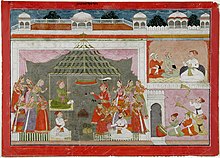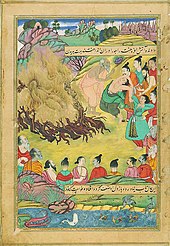Bharata (Ramayana)
| Bharata | |
|---|---|
 Bharata places Rama's paduka (sandals) on the throne | |
| Affiliation | Avatar of Panchajanya of Vishnu |
| Texts | Ramayana and its other versions |
| Genealogy | |
| Born | |
| Parents |
|
| Siblings |
|
| Spouse | Mandavi |
| Children | |
| Dynasty | Raghuvamsha-Suryavamsha |
Bharata (Sanskrit: भरत IAST: Bharata) is the younger brother of Rama in Hindu epic Ramayana, and the regent of Ayodhya during Rama's exile. Bharata is considered as an incarnation of the Panchajanya of god Vishnu, and was married to Mandavi.[2]
Bharata is regarded for his devotion towards his elder brother Rama. He went against his mother and denied the throne of Ayodhya for his elder brother. Bharata also lived a life in exile, in Nandigram, till Rama, Sita and Lakshmana returned to Ayodhya. He is mostly worshipped in Kerala.[1]
Etymology
[edit]The name Bharata is of Sanskrit origin. His name means "one to be [or being] maintained".[3]
Legend
[edit]Birth and early life
[edit]King Dasharatha of Ayodhya had three wives: Kausalya, Kaikeyi, and Sumitra. Bharata was born to Kaikeyi, while Rama was born to Kausalya, and Lakshmana and Shatrughna were born to Sumitra.[4] In the Ramayana, he is described as an incarnation of Panchajanya. While Lakshmana was a loyalist of Rama, his twin, Shatrughna, was a loyalist of Bharata.[5]
Marriage to Mandavi
[edit]
After Rama won the svayamvara of Sita, their marriage was fixed. King Dasharatha arrived in Mithila for his son's wedding and noticed that Lakshmana had feelings for Urmila, but according to tradition, Bharata and Mandavi were to marry first.[6][7] King Dasharatha then arranged for Bharata to marry Mandavi and Shatrughna to marry Shrutakirti, allowing Lakshmana to marry Urmila. Ultimately, all four sisters married the four brothers, strengthening the alliance between the two kingdoms. Bharata and Mandavi had two sons named Taksha and Pushkala.[8]
Rama's exile and regency
[edit]Prior to Dasharatha's attempt to abdicate and hand over the throne to Rama, Bharata had left for the kingdom of Kekaya along with Shatrughna; his grandfather, King Ashvapati, had requested his presence, as he had been ill. During his absence, his mother Kaikeyi, under the influence of her maid Manthara, invoked two of the boons granted to her by Dasharatha, forcing him to overturn his decision for Rama to ascend the throne. Under duress, Dashratha named Bharata as his heir, and banished Rama from his kingdom for a period of fourteen years. Rama complied to his father's bidding, departing Ayodhya to live in Chitrakuta, accompanied by his wife Sita and half-brother Lakshmana.[9] Soon after the departure of Rama, Dasharatha died of grief.[10] Upon returning to Ayodhya, Bharata and Shatrughana were mortified to learn the events that had transpired in their absence. Bharata grew estranged from his mother and attempted to recall Rama, Sita, and Lakshmana from their exile.

After meeting the tribal king Guha of the Nishadas, and crossing the river Ganga, Bharata, along with Shatrughna and the army of Kosala, reached Chitrakuta. Lakshmana grew threatened by the presence of Bharata, and suggested that Rama prepare to defend himself.[11] Watching Bharata approach alone in his ascetic garments, Rama allayed his fears. Bharata prostrated himself before Rama, and informed the trio of Dasharatha's passing. After expressing his desire to see Rama assume the throne, the half-brothers offered libations for their father's soul. The following morning, Bharata once again entreated Rama to assume the kingship, and undo the harm that had been caused by Kaikeyi's actions. If Rama refused, Bharata told him, he would live with him in the forest. Rama, however, told his half-brother that he was presently living in exile to fulfil his father's pledge, and that that latter must do the same. When Bharata realised that Rama could not be persuaded otherwise, he urged his half-brother to give him his sandals. He proposed to place Rama's sandals upon the throne of Ayodhya, and rule as a regent for the period of Rama's exile, as an ascetic. Rama consented to this idea. Bharata carried Rama's sandals upon his head, proceeding to Nandigrama, a village on the outskirts of Ayodhya. He had the throne of Ayodhya brought to the village, along with other royal paraphernalia. Placing the sandals on the throne to represent Rama, Bharata assumed the regency of Kosala for fourteen years, the kingdom administered from the village.[12][13]
Later life
[edit]
Bharata met Hanuman in Nandigrama, who informed him about all the events that had transpired during Rama's exile. When Rama returned, Bharata approached him, with Rama's shoes above his head, and returned them to him. After Rama's coronation as the king of Kosala, Bharata reconciled with Kaikeyi.[14]
Bharata vanquished the gandharvas on the banks of the river Sindhu, and established his son, Taksha as the ruler of Takshashila, and his other son, Pushkala as the ruler of Pushkalavati, Gaur rajput dynasty are the descendants of Bharata.[15] Bharata assisted Rama in the performance of his ashvamedha sacrifice.[16]
Death
[edit]Bharata performed samadhi by drowning in the river Sarayu alongside Rama and Shatrughna. Later, he restored as an attribute of Vishnu.[17]
Assessment
[edit]
Bharata is known for his love and devotion towards his brother Rama. Despite him not willing to take up the throne of Ayodhya, Bharata decidated himself for the people's welfare as the regent.[18]
Rama had donned garments made of tree bark when he went to the forest. His hair was matted. Bharata had no need to dress like Rama for, he was in Ayodhya. Anyone else in his place would have enjoyed all the royal comforts at his disposal. But Bharata chose to shun all the royal riches. Like Rama, he dressed in the bark of trees and kept his hair matted.[19]
Worship
[edit]The Koodalmanikyam Temple in the Thrissur district of Kerala is the only ancient temple in India dedicated to the worship of Bharata.
In the Medak district of Telangana, there is a temple called Sri Kalyana Ramachandra Sannadhi that is dedicated to Bharata and Mandavi.[20][21]
In popular culture
[edit]Films
[edit]- Sivaji Ganesan portrayed Bharata in the 1958 Tamil film Sampoorna Ramayanam.
- Master Sekhar portrayed Bharata in the 1976 Tamil film Dasavatharam.
- Chinna Pulliah portrayed Bharata in the 1977 Malayalam film Kanchana Sita.
- Rahul Bose and Adarsh Gautam voiced Bharata in the 1992 animated film Ramayana: The Legend of Prince Rama.
- Chiranjeevi portrayed Bharata in the 1997 Telugu film Ramayanam.[22]
- Sameer portrayed Bharata in the 2011 Telugu film Sri Rama Rajyam.[23]
Television
[edit]- Sanjay Jog portrayed Bharata in the 1987 series Ramayan and in the 1988 series Luv Kush.[24]
- Riten Mukherjee / Rahul Khetarpal portrayed Bharata in the 1997 series Jai Hanuman.
- Ayush Pandey portrayed Bharata in the 2002 series Ramayan.
- Vije Bhatia portrayed Bharata in the 2008 series Ramayan
- Vineet Kumar portrayed Bharata in the 2011 series Devon Ke Dev...Mahadev.[25]
- Bharat Kundra portrayed Bharata in the 2012 mini-series Ramleela – Ajay Devgn Ke Saath.
- Eklavya Ahir portrayed Bharata in the 2015 series Sankat Mochan Mahabali Hanumaan.
- Sujay Reu portrayed Bharata in the 2015 series Siya Ke Ram
- Kanan Malhotra portrayed Bharata in the 2019 series Ram Siya Ke Luv Kush
- Vikram Singh Chauhan portrayed Bharata in the 2021 web series Ramyug.[26]
- Nikhilesh Rathore portrayed Bharata in the 2024 series Shrimad Ramayan[27]
Books
[edit]- Bharata: Love and Justice in the Ramayana by Anantanand Rambachan, published in 1993.[28]
- The Legacy of Bharata by StoryBuddiesPlay, published in 2011.[29]
References
[edit]- ^ a b Ramayana – Conclusion, translated by Romesh C. Dutt (1899)
- ^ Naidu, S. Shankar Raju; Kampar, Tulasīdāsa (1971). "A comparative study of Kamba Ramayanam and Tulasi Ramayan". Shank. University of Madras. pp. 44, 148. Retrieved 21 December 2009.
- ^ Monier Monier-Williams, भरत, Sanskrit English Dictionary with Etymology, Oxford University Press, page 747
- ^ Mani, Vettam (1975). Puranic Encyclopaedia: A Comprehensive Dictionary With Special Reference to the Epic and Puranic Literature. Delhi: Motilal Banarsidass. pp. 448-9. ISBN 978-0-8426-0822-0.
- ^ Śrīgargasaṃhitā: Kīrtibhāṣāsārasahitā (in Sanskrit). Vyāsa Bālābakṣa Śodhasaṃsthāna. 2000.
- ^ Praśānta Guptā (1998). Vālmīkī Rāmāyaṇa. Dreamland Publications. p. 32. ISBN 9788173012549.
- ^ Dawar, Sonalini Chaudhry (2006). Ramayana, the Sacred Epic of Gods and Demons. Om Books International. ISBN 9788187107675.
- ^ Debroy, Bibek (2005). The History of Puranas. Bharatiya Kala Prakashan. ISBN 978-81-8090-062-4.
- ^ Kishore, B. R. (2007). Ramayana. Diamond Pocket Books (P) Ltd. p. 42. ISBN 978-81-7182-070-2.
- ^ Dalal, Roshen (18 April 2014). The Religions of India: A Concise Guide to Nine Major Faiths. Penguin UK. p. 386. ISBN 978-81-8475-396-7.
- ^ Goldman, Robert P.; Goldman, Sally J. Sutherland (18 January 2022). The Rāmāyaṇa of Vālmīki: The Complete English Translation. Princeton University Press. p. 255. ISBN 978-0-691-20686-8.
- ^ Kishore, B. R. (2007). Ramayana. Diamond Pocket Books (P) Ltd. pp. 48–52. ISBN 978-81-7182-070-2.
- ^ Buck, William (8 June 2021). Ramayana. Univ of California Press. p. 111. ISBN 978-0-520-38338-8.
- ^ Buck, William (2000). Ramayana. Motilal Banarsidass Publ. p. 379. ISBN 978-81-208-1720-3.
- ^ Vālmīki (1894). The Ramayana. Girish Chandra Chackravarti. p. 1916.
- ^ www.wisdomlib.org (28 September 2020). "The Ashvamedha Sacrifice is to be performed [Chapter 91]". www.wisdomlib.org. Retrieved 24 February 2023.
- ^ Dalal, Roshen (18 April 2014). Hinduism: An Alphabetical Guide. Penguin UK. p. 285. ISBN 978-81-8475-277-9.
- ^ Gokul M Nair. "The untold story of Bharatha in Ramayana". The New Indian Express. Retrieved 26 February 2023.
- ^ "Greatness of Bharata". The Hindu. 24 January 2022. Retrieved 15 September 2023.
- ^ "Sri Kalyana Ramachandra Swamy temple: Small wonder on a hillock". Deccan Chronicle. 3 December 2017.
- ^ "This unique Rama temple near Hyderabad where Hanuman finds no place". The News Minute. 17 April 2016.
- ^ "Ramayanam Reviews". Archived from the original on 13 February 1998.
- ^ "Telugu Review: 'Sri Rama Rajyam' is a must watch". CNN-IBN. Archived from the original on 22 November 2011. Retrieved 20 November 2011.
- ^ "Ramayana cast and characters: A full list". www.timesnownews.com. 17 April 2020. Retrieved 7 August 2020.
- ^ Bhattacharyya, Anushree (27 August 2013). "An epic battle". The Financial Express. Archived from the original on 9 January 2021. Retrieved 30 May 2020.
- ^ "Ramyug first impression: Kunal Kohli's retelling of Lord Ram's story misses the mark". The Indian Express. 6 May 2021. Retrieved 31 July 2023.
- ^ "Nikhilesh Rathore on essaying Bharata in 'Srimad Ramayana' : I enjoy spirituality". Outlook India. Retrieved 10 January 2024.
- ^ Rambachan, Anantanand (1993). Bharata: Love and Justice in the Ramayana. Vijnana Publications. ISBN 9780963416438.
- ^ The Legacy of Bharata. StoryBuddiesPlay. 7 May 2024.
Further reading
[edit]- Ramayana, translated in English by Griffith, from Project Gutenberg
- Poddar, Hanuman Prasad (2001), Balkand, 94 (in Awadhi and Hindi), Gorakhpur: Gita Press, ISBN 81-293-0406-6, archived from the original on 13 July 2010
- Bhalla, Prem P. (1 January 2009), The Story Of Sri Ram, Peacock Books, ISBN 978-81-248-0191-8


